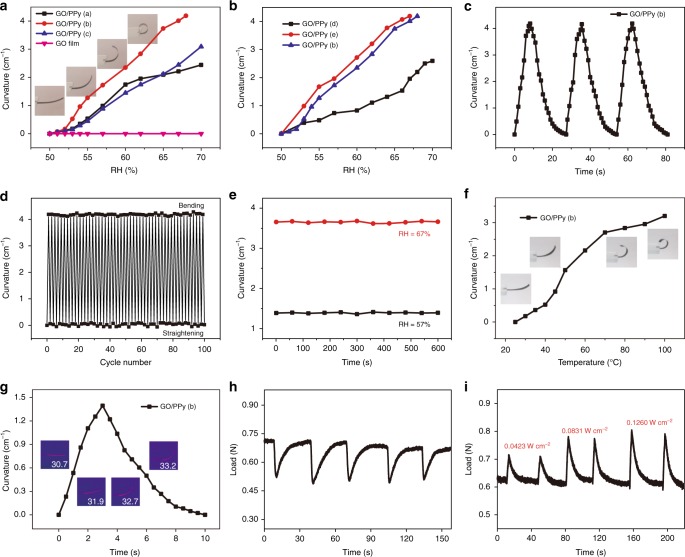Fig. 3.
Actuating performance of GO/PPy actuator. a Actuating performance of GO/PPy actuators under the stimulus of humidity, (GO/PPy (a), GO/PPy (b) and GO/PPy (c) represent GO/PPy actuators with different GO thicknesses of 12.8, 25.2 and 37.1 μm, respectively) (the insets are photographs of the bending GO/PPy ribbon under different RH values); b Actuating performance of GO/PPy actuators under the stimulus of humidity, (GO/PPy (d), GO/PPy (e) and GO/PPy (b) represent GO/PPy actuators with increasing PPy thicknesses and same GO thickness of 25.2 μm; c switching from the bent to the straight state of GO/PPy (b) by changing the corresponding RH from 50 to 68%, and vice versa; d cyclic stability of the curvature of a GO/PPy actuator over 100 cycles (50–68% RH); e durable behavior of GO/PPy (b) after exposure to 57% or 67% RH for 600 s; f actuating performance of GO/PPy (b) under the stimulus of temperature (the insets are photographs of the bending GO/PPy ribbon at temperatures of 25, 50 and 100 °C); g actuating performance of GO/PPy (b) under the stimulus of IR light (the insets are photographs of the bending GO/PPy (b) at different times); h the bending force of GO/PPy (b) actuator recorded during the process of turning on/off the humidifier; i the contractile force of GO/PPy (b) actuator recorded during the process of turning on/off IR light with power densities of 0.0423, 0.0831 and 0.126 W cm−2 (from left to right)

